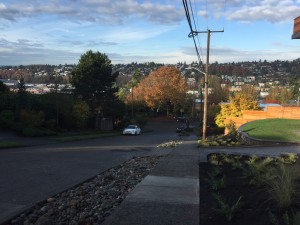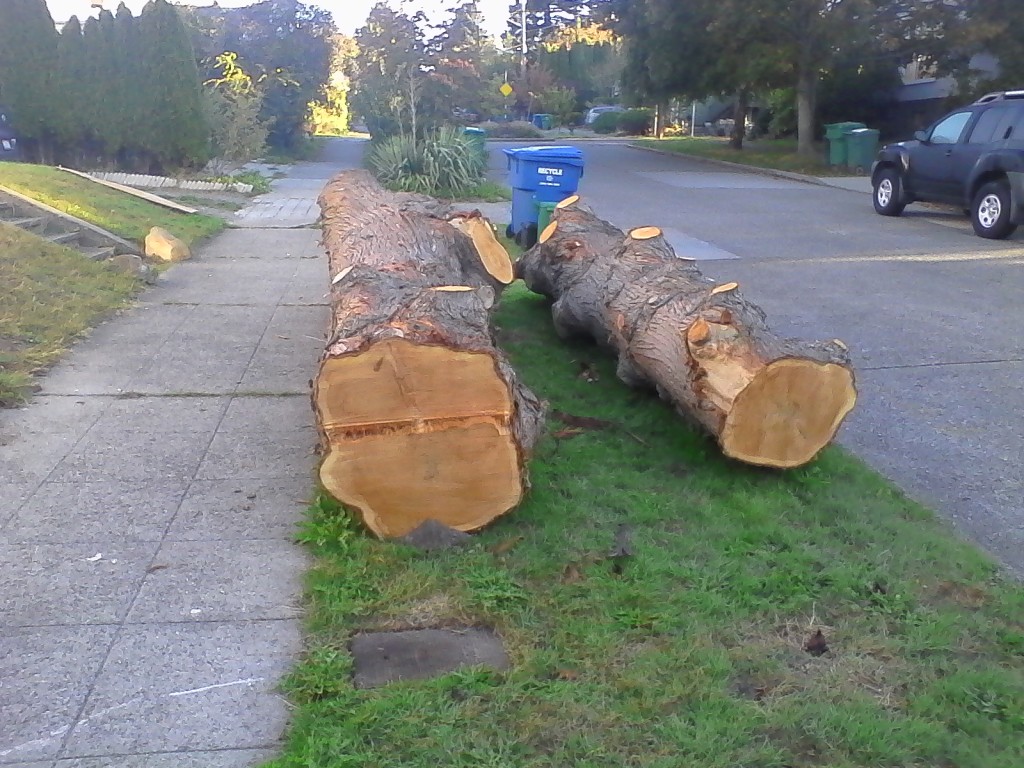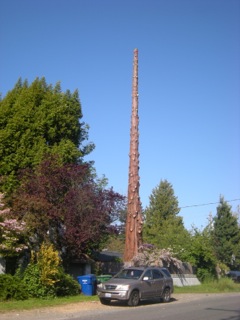This is a page where we will post stories we hear in the fight to save and protect trees that spur us on to do more. Send us your horror stories and we will post them here to share with others.
____________________________________________________________
Subject: Appeal to tree grove
01/10/2017
Mr. A.M.,
I just noticed your comments from a year ago on the proposed subdivision of a 6,000 SF lot at 2602 14th Ave W (and 2600 14th Ave W) and not sure if you ever received a response.
As you may have seen recently during the holidays, the City has published a decision to accept this proposal even though it does not meet zoning and environmental codes. I’ve had a similar example of this type of low-rise residential over-development being built next to my home is east Magnolia.
Appeals of this decision must be received by the Hearing Examiner no later than 1/12/2017.
In addition to your stated concerns in December 2015, there are other reasons why this should not be allowed to proceed as submitted, including the following:
- The original lot is 50 ft x 120 ft or 6000 SF. Per the density code, the number of dwellings within this zoning LR1 area is calculated as follows:
- 6,000 SF site / 1,600 factor = 3.75 dwelling units.
- Only decimals of .875 and greater may be rounded up since Aug 2015.
- Thus a maximum of 3 dwellings may be built rather than 4 shown.
- The developer has tried to circumvent the zoning requirements by subdividing the properties and ignoring the parent site configuration.
- the arborist has identified 11 trees on this site (16 in total) – most on a critical slope greater than 40% pitch… and neglected to indicate that the criteria for tree preservation is more restrict in ‘groves’ of trees as well as trees within designated Environmentally Critical Areas (ECA).
- the proposed 2-story high narrow retaining wall built over the existing ECA steep slope area for 4 parking spaces is a geological disaster just waiting to happen.
=============================================================
DESCRIPTION:
Area: MAGNOLIA/QUEEN ANNE Address: 2602 14TH AVE W
Project: 3023412
Zone: LANDFILL, LOWRISE-1, POTENTIAL SLIDE AREA, AIRPORT HEIGHT DISTRICT
Decision Date: 12/29/2016
Contact: BRADLEY KHOURI – (206) 297-1284
Planner: GERALD SUDER – (206) 386-4069
Land Use Application to allow two, 3-story single family residences in an environmentally critical area. Surface parking for two vehicles to be provided. Existing structure to be demolished. Environmental review includes future unit lot subdivision. The following appealable decisions have been made based on submitted plans:
Determination of Non-Significance (no environmental impact statement required). Environmental review completed and no conditions imposed. This DNS is issued using the optional DNS process in WAC 197.11.355 and SMC 25.05.355. The comment period was originally published on March 10, 2016 and there is no further comment period on this DNS.
____________________________________________________________
Subject: project 3022986 – 10540 Greenwood Ave. N in Seattle
please save any/all trees on the property. I can see one right there at curbside in the phinneywood pic: http://phinneywood.com/2016/12/12/comment-on-any-environmental-concerns-on-development-at-10540-greenwood-ave-n/ but I’m sure there are others. It’s looong past time to STOP cutting trees down to serve the almighty developer dollar – SAVE them please!
K.G.
____________________________________________________________
Subject: Why remove mature tree?
The autumn golden leaf tree at the T-intersection of 13th Ave W and W Reye
St in Queen Anne does not need to be removed in order to build the proposed
development and driveways.
It is in the northeast corner of the property which is scheduled to be
planted and landscaped. Hence, maintaining this tree follows the intent of
the tree protection standards within Seattle.
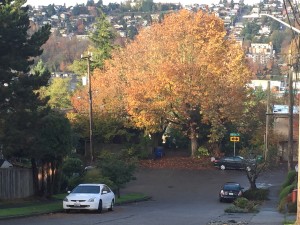 Please contact the City SDCI and developer / owner to explain why beneficial
Please contact the City SDCI and developer / owner to explain why beneficial
mature trees are targeted for removal.
Please contact me or the property neighbors regarding should you have any
question.
Needless to say, Seattle needs homes. Seattle doesn’t need overly zealous
lumberjacks 😉
https://www.change.org/p/mayor-ed-murray-protect-seattle-trees-now
____________________________________________________________
Kincade Ravine, UW
10-26-16. According to a presentation by UW representative, the University of Washington’s new Urban Forest/Landscape Pan has no inventory or specific protections for the trees in Kincade Ravine. Here is a set of emails about related tree removals sent to us in 2015. -CT
____________________________________________________________
Wed, Aug 26, 2015
Dear Turnbull,
I left a voice message for you and am sending this email also.
The UW is planning to clearcut Kincaid Ravine, cutting down approximately 210 trees, 90 of which are “significant trees”. The # of the project is 3020291, Seattle Dept. of Planning and Development.
I’m part of a (currently) small group of people who are trying to get this stopped and I was referred to you.
Can you help?
____________________________________________________________
Wednesday, August 26, 2015
Subject: Re: Kincaid Ravine Clearcut & Developed
Website for DPD: http://web6.seattle.gov/dpd/edms/
Project #3020291
____________________________________________________________
Saturday, August 29, 2015
Cass,
Good morning. First of all, to clarify, the ravine is not near Kincaid Hall on the UW campus. The ravine is located at the NE corner of the campus, bordering 45th St. and the 45th St viaduct, between McCarty Hall and the Burke Gilman Trail. On the Burke Gilman Trail, there is a notice of development. I haven’t seen the notice at the top of the ravine (near McCarty), but I assume there is one. I have attached a map of the proposed development. The ravine will not be developed, but the upper portion, near McCarty Hall, will be. Below is text from the Seattle Dept. of Planning and Development website.
http://web6.seattle.gov/dpd/edms/
Project # 3020291
Copied from SDR Report (p.2) on above website:
“ECAs: Several environmentally critical areas (ECA) are located in the immediate area including steep slopes and peat settlement prone areas.
PROJECT DESCRIPTION
The University of Washington is planning to replace two residence halls, McCarty Hall and Hagget Hall with new residential living communities. The project proposal is to provide 823 residential units in three buildings. The main objectives are to visually and functionally reconnect the residential area with the main campus, to embrace surrounding natural areas, and to replace aging structures. The University of Washington arboreal collection is large, varied, and mature. New development will necessitate removing and replacing trees. Approximately 219 trees are slated to be removed due to demolition and future build-out. 90 of those trees meet the DPD definition for exceptional trees. Some trees are in declining health or dead. Some trees will be transplanted. Removal of exceptional trees requires a Streamlined Design Review process. Project drawings can be found in the DPD electronic file for this project and at the Seattle Municipal Tower floor 20 Public Resource Center.”
Hope this helps Please let me know if there is anything else I can do.
____________________________________________________________
FOLLOWUP: City grants ‘special exception’ land-use permit to build house where huge Admiral tree stands
Four months ago, we reported on an Admiral neighborhood’s hopes of saving a huge Ponderosa Pine tree that is on a site where its new owner wants to build a house.
Getting a land-use permit for the proposal at 3036 39th SW [map] was dependent on getting a “special exception” from the city, allowing a house on a lot smaller than 3,200 square feet..
Today’s Land Use Information Bulletin includes this notice of the city’s decision to grant the exception.
____________________________________________________________
Subject: Important Update on the Urban Forest @ 6025 53rd Ave NE
We Stand for the Urban Forest
Dear Friends,
Seattle is rapidly losing the urban forest located at 6025 53rd Ave NE to development. This site has been home to large pileated woodpeckers and Cooper’s hawks. Before development began in October 2016, the forest was so dense that the original homestead, now open to view, could hardly be seen. A site this large, with so many mature trees, including snags that can feed and shelter pileated woodpeckers, is a rarity in the city.
Recognizing the value of this site to birds, other wildlife, and our city, the Audubon Society began to advocate for its protection in January 2016, but were unable to convince the city to buy it or halt development.
According to friend’s of the forest, the developer, Chris Faul, paid over 3 million dollars for the site and plans to build nine units where currently there is a single home. Chris Faul was one of the founding partners of Point32, the firm that developed the Bullitt Center, hailed as the greenest commercial building in the world.
Given Faul’s involvement in the development of the Bullitt Center & Point32’s ties to The Trust for Public Land, which protects properties such as this forest by buying them, often in partnership with conservation groups, his development of this sensitive site is especially disappointing and shocking.
Friends of the forest also note that many trees have already been taken down in apparent violation of the city’s Tree Protection Ordinance, Seattle Municipal Code (SMC) 25,11, as well as the Environmentally Critical Area Code, SMC 25.09. Unless the city levels fines that are commensurate with the scale of this development, they will likely be “the cost of doing business,” rather than true deterrents to urban deforestation.
What you can do:
Visit the forest and witness the loss, keeping in mind that many trees have already been removed.
Spread the word friend-to-friend or via social media, such as Facebook or Twitter.
For those with Twitter accounts, please consider retweeting the new tweet linked below. I have included a link in the tweet to this letter so that people can better understand this matter. Retweets can help to inform and galvanize concerned citizens.
New Tweet: Trees Don’t Need Solutions Like These
Write to the Seattle City Council at council@seattle.gov urging them to enforce and strengthen the existing Tree Protection Ordinance so that replacement of cut trees is required either on the same property or through a mitigation bank elsewhere in the city. Feel free to use the sample letter copied below.
Sincere thanks to everyone who has visited, and written on behalf of, this urban forest.
Kerry
Sample Letter
To Members of the Seattle City Council:
I am writing to express my concern about the ongoing loss of the beautiful urban forest at 6025 53rd Ave NE. This area is home to large pileated woodpeckers and Cooper’s hawks. All for the purpose of making money, this area is being developed and trees are being cut down without any regard for preserving Seattle’s urban forest for future generations.
The Seattle City Council should stop this right now. It is in violation of the city’s Tree Protection Ordinance, Seattle Municipal Code (SMC) 25,11, as well as the Environmentally Critical Area Code, SMC 25.09.
The Council should also take the lead in preventing this sort of thing from happening elsewhere in the city. Please do whatever you can to order the City to rewrite its tree ordinance for private property so that permits are required to cut trees and replacement is required either on the same property or through a mitigation bank elsewhere in the city. Even though trees are located on private property, they have community value for runoff retention, wildlife, carbon sequestration, oxygen production, shade, etc. Please enforce and strengthen the existing Tree Protection Ordinance to make it impossible for developers to ruin our environment.
Thank you for your prompt attention to this matter.
Sincerely,
Name
Seattle Address
____________________________________________________________
Issues with proposed subdivision
Brandon Davis
c/o Public Resource Center; PRC@seattle.gov
Seattle Dept. of Construction & Inspections
PO Box 34019
Seattle, WA 98124
There are several issues with the proposed subdivision of an existing lot at 2573 13th Ave W into 4 rowhouse unit lots at the top of a steeply sloping Envionmentally Critical Area:
(A) Subdividing into 4 uniot lots results in the 2 center unit lots exceeding the allowable floor area to site area ratio by almost 25%. Either fewer rowhouses to be provided on wider lots; or the 2 rowhouse units B & C must be made smaller in floor area. Units B and C exceed the allowable FAR of 1.0. (2284SF Unit Area / 1863SF sites = FAR of 1.23). Sheet A4.01 shows average grade 2 feet higher than first floor.
(B) There is disregard to the balance of trees and buildings on this unique Seattle LR-1 zoned lot. Of 1the approximately 8 trees on site, there are 3 to 5 trees that should not be removed in order to be compliant with tree protection rules of the SMC. Healthy trees 24″ DBH (and 6″ DBH within the ECA) must be protected and not removed – especially two trees marked as 26″ DT near the northeast corner or within the Seattle Light easement – as they are in locations of proposed planters. If sightlines (Site triangles) are deemed the reason to remove these exceptional trees, then the proposed driveway may be shifted further south in order fo the sightline to be clear. If anything, the existing / proposed driveway with two large old Maple trees have co-existed for years and should not be grandfathered as maintaining the current acceptable condition.
- Arborist has missed several large trees shown in the Report overhead view that are marked on the site plan. Arborist to inventory all trees over 6″ DBH.
- Arborist stating a higher level of exceptional trees at 30″ DBH rather than 24″ DBH. Is this an error or a recent change in the tree protection code?
- Arborist measured DBH is not reflected or coordinated with the site plan and topographic survey. Which document prevails?
- If a tree is wider than 24″ diameter above the 54″ DBH height, iks it still deemed as ‘not exceptional?’ . See Arborist photo of Tree 4 Bigleaf Maple and explain how this tree is called out to the not exceptional. This tree shouldl not be removed suggesting it doesn’t meet the size parameters.
- Likewise, the 22″ Black Locust and 22″ Cedar are also likely to be exceptional trees if remeasured by an independent arborist who is not being paid by a propoerty developer. There is several conflicts of interests evident in this arborist report that require independent field review.
EXISTING MATURE TREES HAVE BEEN SEVERELY DISREGARDED ON THIS WOODED SITE.
(C) The buildings are 12″ to 18″ too tall relative to the average grade (see drawing A3.00 and A3.02) – noted ave grade of 191.66′ appears arbitrary.
(D) Note 19 on the cover sheet indicates no grading between Oct 31 and April 1. If Director decides if grading is permitted in this time period, please identify what measures will protect the adjacent properties and alley ROW.
(E) Windows in proposed unit A invade the privacy to existing house at 2569 13th Ave W (see A3.02), and is not compliant with privacy rules.
(F) Existing house to be demolished is likely to have asbestos materials and lead paint that will be an environmental hazard to neighbors and demolition crews.
(G) Unit A should be shifted in order to avoid additional loading at the top of a steep slope unless a geotechnical engineer can calculate the risk and minimize land slides onto properties to the north and west.
(H) Trash inside building’s garage is unlikely as the chance for waste odors to enter the interior of the home. Waste containers will likely be left outside by 1 or more owners – thereby needed screening of trash from adjacent properties.
(I) Finish grades steeper than 2:1 as shown on sections of drawing A1.01 are suseptable to erosion or settlement of the neighbor’s property to the south,
(J) SMC required 50% of adjacent sites to be shown, verify that minimum distance between driveway curbcuts complies with adjacent curb cuts.
David Moehring
REF: http://web6.seattle.gov/DPD/LUIB/Notice.aspx?BID=1178&NID=23485&EM=Y
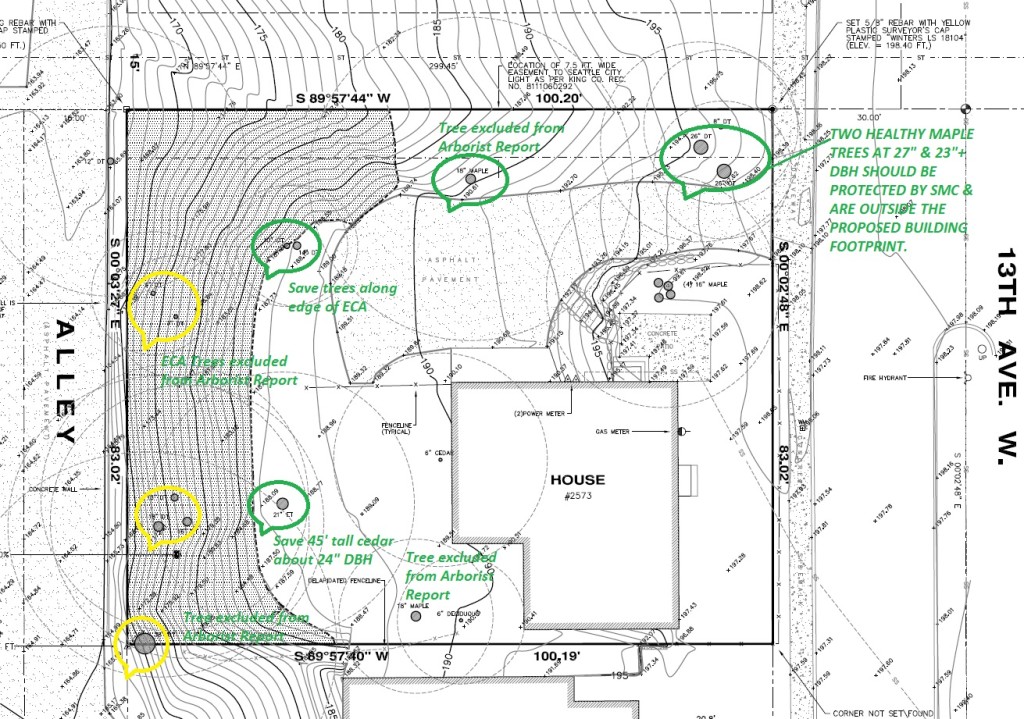
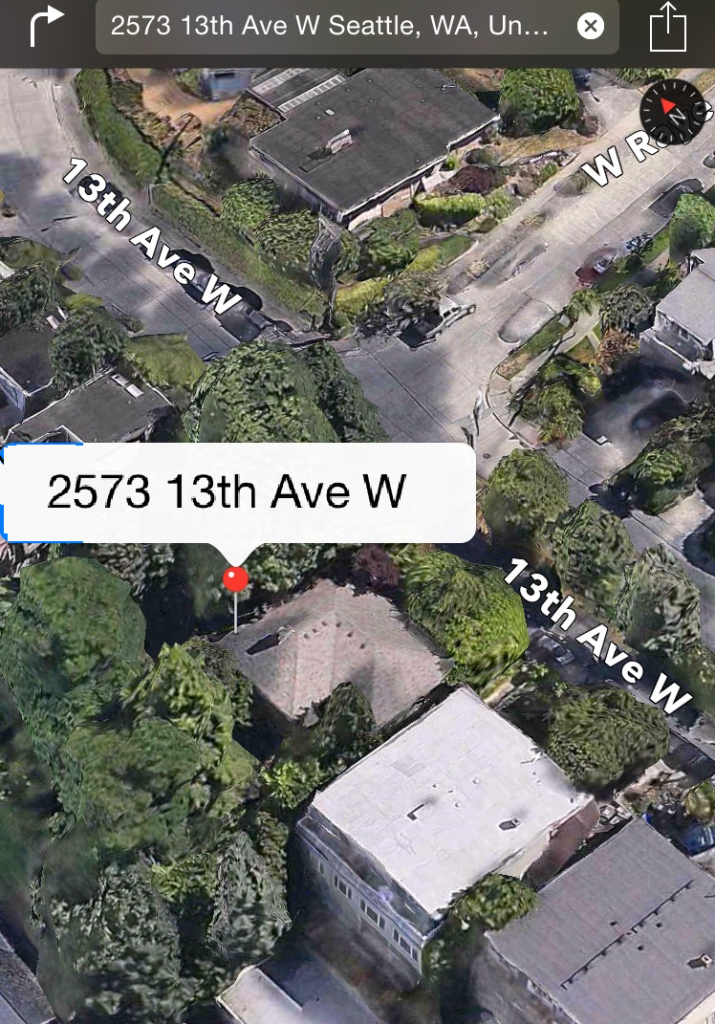
____________________________________________________________
Environmentally critical areas
If the trees are on a slope, it’s likely designated as an environmentally critical area (ECA) which establishes some protections for trees. You can report removals through the Department of Construction and Inspection’s (DCI) complaint page (below).
http://www.seattle.gov/dpd/codesrules/makeacomplaint/default.htm
If you ever see anyone in the act of removing trees on such land, you can request to see their permit.
If not permit is provided, call (206) 615-0808 which is better than emailing. Be sure to let us know how it went and the outcome.
____________________________________________________________
Potential dismantling of a significant grove of evergreens in Fremont
For the past number of months, my neighbors and I have been following the potential dismantling of a significant grove of evergreens in Fremont, at 4106 Linden Ave N. The property contains a lot of evergreens in the front yard (including an exceptional Monkey Puzzle Tree) that touch canopy with evergreens on the property to the south, as shown below:

We first became aware of the threat to the grove when one of the neighbors who was alert heard a chain saw, which turned out to be sound of a person up in the Monkey Puzzle Tree, sawing off limbs. To make the story shorter, she waited below and refused to leave till the fellow came down and measured it. Once he determined that the tree’s girth was large enough to qualify as “exceptional”, he left the property. Then, as is typical, the development of the property into townhouses was segmented – one yellow sign after another (a total of three) showed up over the next few weeks. Each land use action was for a different thing, and I for one could not figure out how the City’s land use department (DPD) could allow one application to follow another like that, especially when we hardly had time to comment on each one. A bunch of us sent letters to DPD objecting to the removal of the trees for the development, citing the grove’s protection under the tree ordinance. As a Fremont historian, I cited the fact that all of Fremont’s evergreen trees had been removed to rebuild the Seattle waterfront after the Great Seattle Fire, and that we needed to hang on to what we have now. All this to no avail.
Two days ago my neighbor alerted me to the fact that now the Monkey Puzzle Tree has yellow caution tape around it, while ALL THE OTHER evergreen trees in the yard have X’s painted on them (see photos below). We tried, but it didn’t matter how much we tried. This is a terrible loss to our community! Come on Seattle, put your land use and tree policies together! We need evergreens to help clean the air year around, to help provide heat control in the city, and to provide habitat for wildlife.
– HM, Fremont resident


____________________________________________________________
FOLLOWUP: Disputed tree cut down at site of proposed 4532 42nd SW development
Originally published on West Seattle Blog November 15
While chainsaws are certainly busy around the city during this break between tree-toppling storms, some tree-cutting in West Seattle this morning had nothing to do with the weather. We learned about it via a video tweet.
Read full story at http://www.westseattleblog.com
____________________________________________________________
West Seattle Cedar story
From XXXX
All – The mature Cedar Tree was a topic of discussion at the July 1st EDG meeting for the proposed development at 4532 42nd Ave SW, but the applicant is ignoring the board’s direction – claiming that it is not an exceptional tree.
“At the time of the FIRST Early Design Guidance, … The Board indicated they were not inclined to support the proposed departure unless careful consideration is given to the preservation of the tree and designing a sensitive building transition to the east and north using modulation and open space provisions. See Board Guidance on pages 3-4 for further information. ”
Below is the link to the staff notes from the July EDG meeting:
http://www.seattle.gov/dpd/AppDocs/GroupMeetings/DRReport3019962AgendaID5505.pdf
Regards
XXXX
—–Original Message—–
All – Below is the link to the public notice of the Design Review Board meeting for project number 3019962. It is located at 4542 42nd Ave SW.
http://web6.seattle.gov/DPD/LUIB/Notice.aspx?BID=1076&NID=20744
Please contact me if you have any questions. 206-940-2255
Regards
XXXX
—–Original Message—–
?
Hey XXX,
I have cc’d members of the Seattle Green Spaces Coalition here — we went through something similar in Ballard when one city dept. declared a Korean Ash a legacy or significant tree, and another dept. came out next day & cut it down.
Here are a few approaches I suggest:
- no tree removal until we know the significance of what we’re removing — require an assessment by city forester or other authority to learn whether or not this is a legacy, significant or other designated tree
- the tree is providing value to the neighborhood, which the developer must respect — aesthetic value, property value enhancement, drainage, oxygen production, carbon sink, habitat, etc.
- the tree is part of the city’s forest canopy & green infrastructure — subject of an upcoming city council resolution in which Seattle’s green infrastructure will be assessed, valued and priced into the city’s asset structure. Beyond aesthetics, the tree provides significant dollar value to the neighborhood and West Seattle peninsula. The Trust for Public Land assessed Seattle Parks in 2011, and found they provide about $500 million a year in benefits and savings to Seattle; the urban forest (2013 Urban Forestry Commission report) provides nearly $25 million in air quality benefits alone.
- the city is required by the growth management act to concurrently develop infrastructure as it builds out. This infrastructure includes green & open space development, which this developer is reducing, not maintaining or expanding,
- at a minimum, if the developer is allowed to remove green & open space, including the tree, the developer must be contractually obligated to replace the open space value in kind, in the form of other green space and trees, in the neighborhood
- Our job as citizens is not to make money for developers. Our job is to keep our community livable and thriving.
Best of luck out there! I’ll be attending in spirit.
HHH
On Nov 4, 2015, at 10:06 AM, XXXX
HHH-
The Junction-based project before the SW Design Review Board on Nov. 5, 2015 is a mixed use building north of QFC. This site has a beautiful existing tree that the developer says needs to be removed to make their project work. I wish the developer would save the tree and redesign their project around it. I was wondering if you were interested in talking to me about this.
I am available to chat today Wednesday (Nov. 4) from 9-2 and sporadically on Thursday (Nov. 5) during the day.
I hope to hear back from you.
Best from XXX
____________________________________________________________
September 29, 2015
6551 23rd Avenue NW
This one was just cut down. Trying to figure out why and if permit. J.D.
____________________________________________________________
September 24, 2015
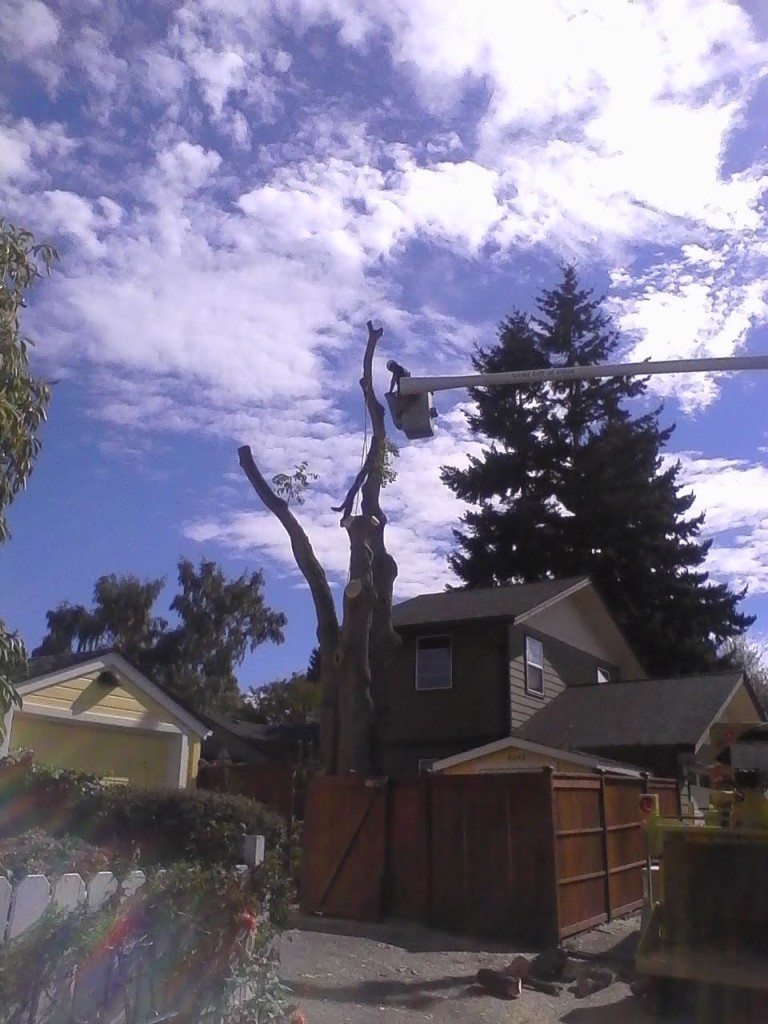
This tree went down today. With Permit. Arborist reported healthy but nuisance to owner. 50 inches. Take a look at application. 3245 27th Avenue West. J.D.
____________________________________________________________
September 17, 2015
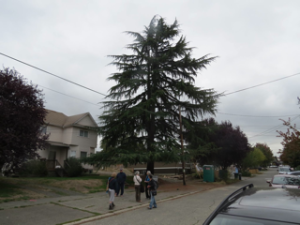 This comment to Department of Planning and Development relates to the proposed destruction of a beautiful exceptional tree living straddling two properties, 2432 and 2436 NW 61st St. in Ballard. The construction project number is 3021411. Why is the foundation already being built before the comment period has ended? Why is there a bulldozer on site?
This comment to Department of Planning and Development relates to the proposed destruction of a beautiful exceptional tree living straddling two properties, 2432 and 2436 NW 61st St. in Ballard. The construction project number is 3021411. Why is the foundation already being built before the comment period has ended? Why is there a bulldozer on site?
This beautiful tree is healthy. I was present when an arborist conducted a tree core sample. I saw no signs of infection or fungus on the tree. The needles looked in great shape. It may be more than 100 years old.
This living and thriving tree is important to the neighborhood. It must be preserved. The owner at 2436 NW 61st St. does not want the tree killed.
One of Seattle’s tree ambassador Diane Shurtlieff has started a Facebook group KeepBallardTreesStanding to save this tree.
Thank you.
MK
____________________________________________________________
Sent: September 6, 2015
Hello,
My name is Randy —– and I live… in Ballard. My former next-door neighbor sold his property to a developer and I’m very unhappy with what has happened since they started work on the property. I came home one day to find that a large bush in my front yard, a huge laurel hedge, and a thirty year old cherry tree had been taken away. In addition to that there is a 38 foot Deodar Cedar in my front yard that they’re trying to get a permit to remove. Large branches have already been cut away from one side of the tree, destroying its balance. I am going to have my property surveyed to see if their line is accurate. I am wondering if there are any resources that you may have to prevent them from removing my beautiful tree as well as with all the other things they have done to reduce my quality of life. I would appreciate any suggestions or resources you may have.
Thanks,
Randy
____________________________________________________________
Sent: September 6, 2015
I am one of about 26 (so far) households in Redmond that are trying to save the lovely trees in our neighborhood. We believe they define our neighborhood as much as a lake view defines those neighborhoods down near Lake Sammamish! We live in an area of half acre lots that are very nicely wooded. We were incorporated into Redmond about 7 years ago and now the market is stronger, the developers have started swarming.
The first half acre lot is now in the planning stages. They were going to let him cut down almost every evergreen tree! Including all the landmark trees (one 48″ across!) Why? For convenience! The lot has nicely spaced large evergreens that could easily be worked around. Of all the trees on the lot, he was going to leave one 24″ evergreen, 3 bitter cherry, 1 evergreen magnolia! He was going to cut down multiple landmark trees, and all the significant trees. We called them out!
We filed an appeal to the plan and it’s now going to the hearing examiner.
We need help! I happened to run into one of your members who told me I should contact Cass! Can you contact me please? We are doing the best we can. There are about 20 more lots with lovely trees. If they all go the way of this one, we will loose a whole forest!
PLEASE, WE NEED YOUR HELP AND ANY ADVICE YOU CAN PROVIDE!
D.Y.
————————————————————
“I’m a 2 year old Tree Ambassador (a fabulous volunteer program through Seattle reLeaf, Seattle Public Utilities). We’re leading two Tree Walks in Ballard September 26.
There is a property that is slated for development with all the trees to be removed. There is a mature, magnificent Gingko on the property. I contacted the City today, the Planner said the submitted report by the arborist made no mention of the Gingko. This is a very large Gingko, hard to miss.
My hope is the City will halt the process (because the arborist’s report is false) and make the desired decision: this tree is an Exceptional Tree. I have photos if you are interested. It is just south of Ballard Community Center on 26th NW & NW Brygger Place. The trunk is significant, although I cannot get close enough to measure it myself.
The building permit has been authorized, so we don’t have much time.
If you have any advice about tactics to save this tree, I would love to hear it. Or, encouraging words!
Sincerely,
—DG”
————————————————————
Sent: Thursday, May 28, 2015
Subject: 22″ American Sweetgum in parking strip destroyed – 7452 E Green Lake Dr North
The over 22-inch diameter American Sweetgum located in the parking strip on Sunnyside at the above address was destroyed but the neighborhood had been told it was to be preserved. The construction operation undertook no real actions to protect this tree.
Of the 19 significant and exceptional trees that had been planted decades ago to be consistent with the legacy of the Green Lake Olmsted Brothers design only one remains because it is jointly owned with the adjacent property owner who commissioned a special survey and took legal and other extreme action to preserve it.
There is additional history to this situation – two exceptional trees on the property that were incorrectly identified in an arborist report were destroyed without proper consideration for preservation and design review as per City requirements. The building plans were permitted BEFORE an arborist report was done, and as mentioned above, a jointly owned Atlas Cedar was identified to be destroyed and was only saved after a stop work order was issued.
This situation needs to be examined and the neighborhood needs an explanation from City representatives.
————————————————————
From: Tess
Sent: Friday, May 15, 2015
Subject: Re: KUOW news report
I attended the Ballard Urban Design Framework community outreach (engagement theater) last week and one thing I would have found laughably misleading, were it not so maddening, was the total misrepresentation of green space in the Ballard hub urban village. (you can look at the Ballard urban design framework plan on the DPD website and see for yourself what I mean.) On one of the poster boards displaying Ballard’s ideal future (as conceived by the DPD) there was a green area centered atop the Ballard Commons and roughly 10 times the size of the Commons. When I asked David Goldberg, the lead on the BUDF, why an area that had already been completely developed was represented in green (which to a less skeptical viewer would have immediately been perceived as a very large park within the Ballard core) he said that the green coloration in the presentation represented a new strategy for creating privately generated green space in HUVs. I asked him if implementation of the strategy requires time travel to a point before all the development, which has now almost completely filled in that area without any privately generated green space, had taken place. I found the presentation by the DPD outrageously misleading and I was shocked by how little skepticism was evident in the attendants.
Tess
————————————————————
From: EG
Sent: Saturday, May 09, 2015 7:59 PM
To: Cass Turnbull
Subject: A beautiful young Sequoia destroyed
Marie and I saw this on our way home last Saturday. The house is at the NE
corner of Greenwood and 115th. (11502 Greenwood Ave N.)
I checked DPD. on Wednesday. No development permits filed. There was a
complaint filed on 5/5 by someone. We have admired this tree for 20 years
and I have been watching for any signs of a for sale sign or DPD planned
development placard… Then, in the blink of an eye… Guess I’ll read up
on what rules there are about trees and private property.
————————————————————
Loss of Giant Evergreen – Giant loss for urban forest canopy
Removed without a permit at 11502 Greenwood Avenue North
I had not seen any DPD Notice of Land Use Action signs up at the property, and when I got to work I decided to check the DPD Permits page to see what was there. There was no information about any permits for this property.
I filed a complaint with the DPD online portal, and then called their number but was on hold waiting for 20 minutes and gave up. I did hear back from the DPD response email and they said there was not a permit issued for this address:
“If the address is 11502 Greenwood Ave N, there are no applications that were submitted to remove any trees. If you wish to file a complaint, you can do so at http://www.seattle.gov/dpd/codesrules/makeacomplaint/default.htm.
If they removed the tree without approval from the City, they will be fined, and possible have to replant more trees.”
Later in the day when I got home from work, I drove by and saw the tree crew wrapping up their work for the day. I stopped and asked what was wrong with the tree. They said that the property owner hired them to clear all the vegetation on the property for a development. I asked if they needed a permit and they said they always work with a permit. I asked if they were going to sell the wood and they said someone else was going to come and chop it into firewood.
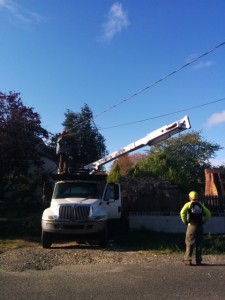 Note the guy on the truck holding up what’s most likely a live electric wire so the truck’s cherry picker can get under the wire and onto the back of the truck. Totally unsafe!
Note the guy on the truck holding up what’s most likely a live electric wire so the truck’s cherry picker can get under the wire and onto the back of the truck. Totally unsafe!
We need to prioritize preserving our Urban Forest Seattle’s Urban Forestry management plan is not working. The fines for tree removal are a pittance of what the tree is actually worth in value to air quality, habitat, and quality of life.
People are not aware of the rules, or even what to do if they think a tree is being removed without a permit. Tree “literacy” needs to be a priority so people understand more about the value of trees in our neighborhoods.
Developers of private property need clearly defined reasons to preserve existing trees, technical expertise on incorporating trees into their developments, and other incentives and variances to their projects. Developers who follow the rules and preserve trees should receive credits, incentives and recognition for their efforts.
The consequences for tree removal do not match the collective loss we all share. Developers are removing trees and paying the fines because they will still make a profit on the development. People who remove trees illegally should receive harsh fines, and be required to plant multiple large replacement trees. If developers scoff at the law, there should be more punitive measures. If possible, serial tree killers who scoff at the laws should be required to do community service planting trees and invasive ivy removal in Seattle’s urban forest.
————————————————————
Letter: Arborcide: 11502 Greenwood North
“This is what’s left of a giant redwood, illegally cut down today around the corner from my house. I filed a complaint with DPD, and they confirmed there is no permit filed with DPD for that address. I sent pics but of course it won’t get the tree back.
The tree guys told me the developer hired them to clear everything on the site for development. “Oh yeah we have a permit.”
What kind of fine happens for this type of flagrant permit violation?
Seattle’s housing market is so crazy right now, our neighborhood (Bitter Lake/Greenwood) is getting cleared and deforested at an alarming rate, 3 projects last month within walking distance. The fines I’m sure are no deterrent. Plus selling the cut wood creates a whole revenue stream.
How do I elevate this? Who cares enough about tree preservation to make this an issue?
Arg, I’m so angry!! It feels like all the tree planting work I’ve done can be negated with one loss of these old beauties.”
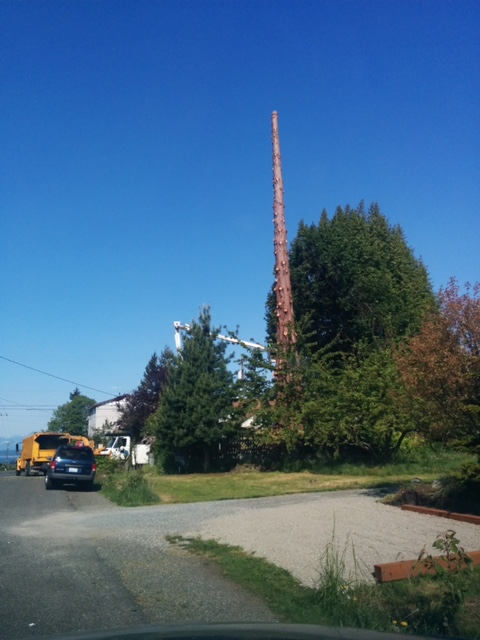
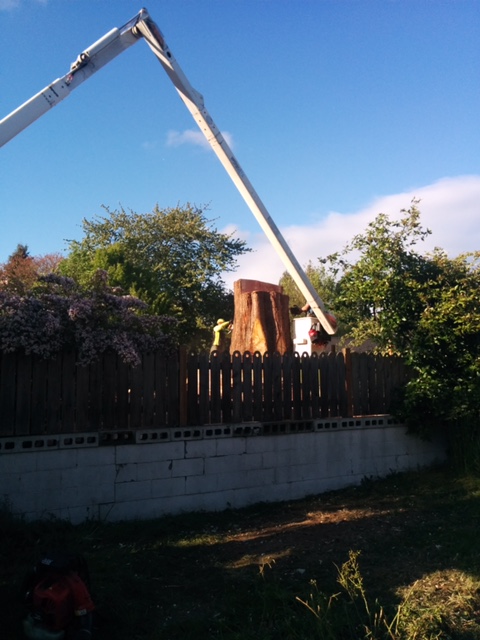
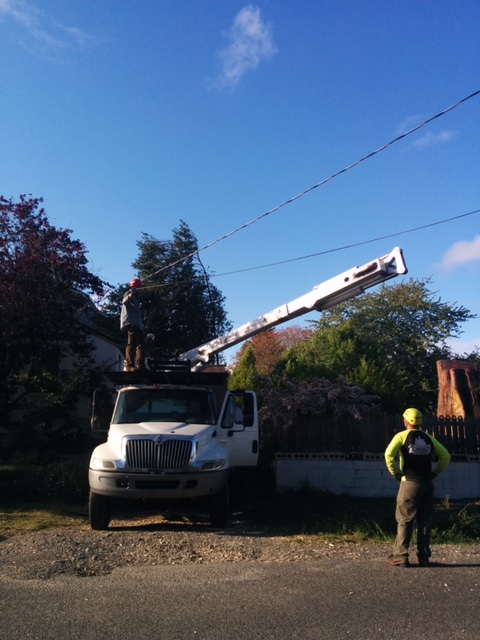

————————————————————
Please read my e-mail correspondence with DPD below.
My intended responses to the planner’s comments are in blue. But note that I am not allowed reply to him/her nor even know his/her name to correct their misinformation. The public is not allowed to call these particular DPD folks, as far as I can tell, ever. I filled out a form on-line.
Apparently if I want to communicate more on this problem, I must start over with a new person by filling out another form on-line, the same form, or start over by going downtown in person, and/or pay them for more help.
Extremely disappointing, but informational about the system.
DPD did not answer my questions, referred me to a committee that I told him I am on, and then gave out incorrect information.
As it turns out, a developer could subdivide the lot, cut down all the trees within proposed footprints of buildings, and any that might be so adversely affected by construction that they might become dangerous. That’s pretty much all of ‘em.
CASS
206-783-9093
From: DPD Q&A Service [mailto:dpdmailer@seattle.gov]
Sent: Thursday, February 05, 2015 11:39 AM
To: Cassturnbull@comcast.net
Subject: DPD Response to your Question
[Please View in Html]
* * * PLEASE DO NOT RESPOND TO THIS EMAIL * * *
Greetings from the Department of Planning and Development.
You recently submitted the following question:
As a member of the City’s Heritage Tree committee I have a question about a Heritage Tree Collection that was approved for the property at 4625 Eastern Ave N. It is 3 building lots together in Wallingford, with a fabulous old house. The owner recently died and the property will be up for sale. How will the buyer know that there is a HT collection on the property? Can they clear cut and say that they didn’t know? What is to prevent the owner from subdividing the lots into three, 5,000 square foot lots which would allow him to then clear off all Heritage Trees, as is my understanding would be allowed. Or does that rule only apply to exceptional trees located in the foot print, not Heritage Trees? Is there a way to flag the property so that potential buyers know there is a Hertiage Tree Collection on that site? If you need to call to answer use the cell phone after 10 am Seattle time as I am traveling 206-295-4936 Thank you for your time,
Cass Turnbull
Here is the DPD response to your question:
Cass,
Thank you for contacting the DPD. This is a question probably better addressed by our Urban Forestry group, (who is that, can you give me their contact information, do you mean division?) which is a part of the City Arborist’s office at SDOT. When developments or land use actions are proposed, the zoning group, which I’m a part of, requires tree preservation, including the maximization of tree retention, and often (but not always? What circumstances can you tell me? these? ) an arborist’s report identifying all trees. We look for what exceptional trees, as well as Heritage Trees. SMC 25.11 is the section of our code that governs tree protection. You may want to read through it, as it outlines the extent of our authority in these matters. I can tell you that subdividing the lot would not grant the owner the ability to clear the trees. If you take a look at SMC 23.24.040.A.6, you’ll find that the criteria for the approval of a short plat includes this this language “…Whether the proposed division of land is designed to maximize the retention of existing trees (not germane I’d say, I want to know if they can subdivide to allow them to remove trees, not keep them)
It is my understanding that all Heritage Trees have a plaque somewhere on the property, (incorrect) and that information regarding them is contained somewhere within the deed (incorrect) . If an owner does remove a Heritage Tree, I believe the fine is significant (who fines them? do you? ) I assume that Heritage Trees are more strictly protected that exceptional trees. And, this isn’t universally true, but many Heritage Trees are also considered exceptional, as they tend to be older, and therefore fairly large. I took a look at the Heritage Tree list that the city keeps, http://www.seattle.gov/transportation/heritagetour.htm, but did not find anything listed at the address you’ve provided. (not all HTs are on the tour,) Does the Heritage Tree Committee not have a contact at the city? ( the HT committee has several City arborists on it) I would contact one of the people listed on this page http://www.seattle.gov/transportation/arborist.htm with specific question about the program. (I understand the HT program I helped invent it, and, as I said, am on the committee have been, on and off, for the last 20 years. What I would was hoping you could explain was DPD roll in protecting HTs when their properties are under development, and can you keep an eye out for this property)
After you have an opportunity to review this information, if you have further questions, please submit your question through this service (you mean start over?) or please visit our Applicant Services Center (ASC location and business hours ) and speak with the staff at our Coaching Counter for general permitting questions. (and start over?) For further land use information you can schedule a paid land use coaching appointment. (pay, go downtown and start over?)
I hope this information is helpful. Certainly it has been instructional.
DPD Planner (no name?)
NOTE: Unless otherwise instructed, please address further inquiries to the online Q&A service.
IMPORTANT LEGAL NOTICE
When you submitted your original question online, you acknowledged the following disclaimer:
DPD cannot offer legal guarantees with respect to the information we provide in response to inquiries made via this website. Our response is meant to be helpful, but we expressly do not assume liability for costs resulting from reliance on this information. In the event of a conflict between information provided in response to an inquiry via this website and a specific determination reached by applying our codes to a submitted project application, the latter controls.
The standards in Seattle’s Land Use and Building Codes and related codes are subject to change.
How these standards apply may also vary depending on specific details relating to the site, or other information not immediately available to us at the time we respond to your question. As a property owner or project applicant you are ultimately responsible for complying with code standards.
* * * PLEASE DO NOT RESPOND TO THIS EMAIL * * *
———————————————————————————————————-
Hi,
I have two Scarlet Oaks that a crazy neighbor keeps topping without my permission. I have two questions: 1.) what can I do about the trees? and 2.) what can I do about her?
The trees are 8″-10″ in diameter and (I think) otherwise healthy (though now hideously deformed).
This is the third time she’s topped them. She topped the first one in June of 2011 (I filed a police report, she admitted doing it, the report was referred to KCPA with charges of Malicious Mischief but the KCPA elected not to prosecute). She topped the second one in May 2011 and when confronted admitted to doing it and promised never to do it again. (A police report was opened in this one too). Last Tuesday we discovered she had topped the second one again. The first topping apparently wasn’t thorough enough for her. I’m in the process of filing a police report on this one now.
I’m sick over the trees and at my wits end over her. I’m concerned that she will come for the rest of the trees (there are 4 or 5 more oaks in the same planting) since she is getting away with this with impunity.
Is there any effective way to lobby the city to take action against this kind of behavior ???
Help…
EMAIL 6
Subject: Killing Trees On Public Property
Hello,
I am contacting you in that my efforts to communicate with the City Arborist (Nolan Rundquist) seem to have gone nowhere. Well over a year ago I began to notice several groups of our native cedars dying out along a lane I frequently walk in my neighborhood. It is on what I think to be city property. Or at least publicly owned. The trees are on the street named Bonair in the North Admiral area of West Seattle. SW Massachusetts drops down onto Bonair as you head west. Near the top of Bonair on the waterside of the road you can see two clumps of cedars that are pretty much dead now. If you look closely around the lower half of the trunks you will see holes drilled into the trunks. It was at that time I began to email the City Arborist. My guess is they were drilled and poisoned by someone just up the hill in who’s view they may be or would be in. New construction has occurred over the time that these trees became noticeably affected.
It disheartens me that someone may think that they can kill trees that belong to all of us and hope no one is the wiser. In my conversations with the City Arborist he has said he is looking into it but without any follow up what-so-ever. I don’t think he really cares too much. The last email he had to me was late last year when he said he was still following up on it. I am hopeful you may be able to help in determining if these trees were intentionally tampered with for someone’s personal gain.
I, like you am a small business owner with not a lot of spare time on my hands or resources. But you are an organizations I respect for all of the good work you have done to educate the community. Is this something you can be of help with?
I am attaching a map of the specific area that the trees are located in.
Thank you for your interest,
AK
EMAIL 5
To: KING News Tips> Subject: clear cutting on parks property I thought someone might be interested in the clear cutting that is in progress on the parks controlled greenbelt on the west side of Queen Ann
This cutting is happening on a steep sloop that is designated as
"critical sloop slide zone". I have contacted the city Arborist,
SDOT, and the SPD and no one is enforcing the current ordinances regarding
tree cutting. They have cut down about ten 60' Maples and several Alders.
What I have heard is that the city doesn't make enough in fines to enforce
the code. I thought it would be of more general interest considering the
Federal Judge that was fined for view cutting in Seward Park, the recent view
conflict in Medina and the slide on Whidbey Is this week. --MJB-
EMAIL 4
Subject: Have a problem with a building developer next door…
I want to say first off that I am the proud steward of one of Seattle’s Heritage Trees-a Giant Sequoia at 6531 40th Avenue SW. I appreciate everything your organization does. That being said, I am hoping that I might be able to speak/email with someone there about something that is going on with new construction going on next to door to me relating to trees, and see if there are any avenues that can be pursued. I have been in touch with Seattle DPD and I do not entirely feel comfortable with the answers they are giving me. Simply stated, the developer purchased a 1920s house with many old trees (many native) and has cut down every single tree on the property (some dating back in age to 60 years and more), including three that their own project manager told me they were being required to keep up as part of their construction permit. I do not think any of them should have come down due to health, and especially not the ones designated by the City for preservation. Each could easily have been kept up with the site plan (in fact I think it would have improved the property). DPD asked them for the paperwork that authorized them to take the trees down (which they don’t have) but DPD is evidently allowing them to provide “arborist reports” on the trees. I am really flabbergasted by this last part. Are the builders supposed to determine what trees are to be kept up and what trees are supposed to be taken down? Can anyone provide some insight and help on this? I’ve looked at how the builder had the overhanging trees “pruned” and I seriously doubt that they ever have had a licensed arborist do anything on the property. I know you’re a grass roots organization but if someone could perhaps respond that would be great.
My neighbor was in touch with the “inspector”
He said
“I talked to the inspector, and he did come out to look at the tree massacre. In his opinion, the trees were part of a “man-made” slope, not a natural slope, and therefore not a critical slope on which trees could not be cut. I don’t know why it makes a difference, but in any case, our neighbor won’t be punished other than getting his hand slapped a little.
EMAIL 3.5
This is absurd! This is a very critical slope! It is designated CRITICAL!
Meg
Subject: Cut on Critical Slope, Environmentally Critical Area, No Permit
,Three massive, beautiful cedar trees were cut without a permit They were smack dab in the middle of a Critical Slope and in a designated Environmentally Critical Area (ECA) in West Fremont.4121 2nd Ave NW, Seattle 98107The owner of the property is an engineer for King County and has blatantly chosen to break the law.
I have seen Great Blue Heron and Bald Eagles in these trees.
Other birds that are now displaced are seen hanging out on the neighbor’s chimney.They are now cut to the ground. The blue house it the guy’s neighbor. We both called the DPD and an inspector from DPD finally came out, but obviously not until it was too late.The tree cutter did not tell his neighbors his intentions.
Any suggestions? Can anything be done to insure the guy pays?Public embarrassment?
Thanks,MP
EMAIL 3
Dear Cass or other TreePAC Member: It would be a shame if the three very large and beautiful trees at 3614 East John are cut down. They are the giants of our neighborhood. Any ideas on what to do? Carol Bailey
Subject: Permit Application #6374028 3614 East John Street Seattle
Greetings: I am inquiring regarding the permit status of a proposed development at 3614 East John Street which I understand has an open Permit application (#6374028) for the removal of three exceptional trees with the intention of building a single family home. I would like to know the status of this application and want to lodge a formal objection to the removal of three old. beautiful, exceptional trees to make way for a building project. Please advise me of the process or resources that explain the process to file my complaint.
Thank you in advance,
EMAIL 2
How Seattle Loses Trees – Case Study – 3636 Wallingford Ave N.
At stake is a large approximately 26 inch diameter Douglas fir tree atop a steep slope. It appears as part of a functional grove of trees when the neighbor’s property is considered. It is part of splitting of a lot for building another house on the property. DPD says 5 parking spaces must be maintained on the original lot. It is saying adding a garage dug into the hillside where the Douglas fir is growing is necessary. Yet building the garage removes 2 street parking spaces yielding a net loss of one parking space. In addition a large conifer would be removed removing significant canopy. Even if the garage was to be build, its could be moved to the north and still save the tree. Doesn’t make much sense. Read Nancy Rottle’s e-mail exchange with DPD.
This points to the urgent need to update Seattle’s interim tree ordinance as well as once again pointing out why the Department of Planning and Development is the wrong department to oversee tree protection. They have a mission to help builders build things and saving trees is not a priority for them as the current case shows.
This project also points out that what is needed during the development process is also a detailed analysis of all the trees and canopy on a lot being developed. Call it a Canopy Impact Assessment. Analyze the project’s overall impact on meeting the city’s goal of reaching a 30% canopy cover by 2037. And require as Portland does and other cities are doing – require tree replacement either on or off site to ensure the city has no net loss on canopy as proposed in the Seattle Comprehensive Plan.
Requiring permits to remove trees, including during development, is one way to track tree loss and canopy loss and assess whether Seattle is losing or increasing canopy over time. Without a permit system to remove trees, we will continue to lose trees and accountability.
__._,_.___
EMAIL 1
To: Seattle Dept. of Planning and Development re: Master Use # 3016387 January 27, 2014
From: BB Wedgwood neighbor, volunteer forest steward in Seattle City parks
Dear Seattle Dept. of Planning and Development,
I am a neighbor that lives one block north of the Thornton Creek elementary school and playfields in NE Seattle in the Wedgwood neighborhood. I, as a member of the public, have the opportunity to respond to the Seattle Public Schools environmental checklist for SEPA regulations and for the City of Seattle Dept. Planning and Development’s Master Use # 3016387 at 7711 43rd Ave. NE, Seattle, WA 98115.
I understand there was a tree inventory/assessment done for the Seattle School District at the Thornton Creek school site. Included in that inventory were a row of 8 Scotch pine (Pinus sylvestris), 4 non-native Birch and 9 non-native deciduous trees (hawthorn, hornbeam and Higan cherry). These trees are slated for removal, according to the master plan. This includes 4 of the 8 Pinus sylvestris. However, the 4 remaining Pinus sylvestris trees are slated for future removal, according to the map provided by the Seattle Dept. of Planning/Development.
The birch trees measure (DBH), diameter at 4.5 feet above ground, at 23”, 33”, and 2 forked at 51”/49” and 47”/48”.
The pine trees measure (DBH), diameter at 4.5 feet above ground, at 41”, 26”, 31”, 33”, and one deciduous tree among them at 15”. Four pines slated for later removal measure (DBH) 37”, 40”, 31”, and 40”.
The remaining 10 deciduous trees measure (DBH), 1 forked with multiple branches (14”, 13”, 10”, 11”, 15”, 4.5”), 1 forked with multiple branches (14”, 13”, 15.5”) and the rest at 11”, 24”, 18”, 13.5”, 16”, 17”, 12”, and 22”.
I don’t understand how so many trees of this size can legally be removed. Is there no protection for these trees? Did the Seattle School District solicit the actual monetary value of these trees by size and/or replacement cost? What financial mitigation/replacement value is the Seattle School Distrcit going to offer in the destruction/removal of these trees?
SEPA checklist 4a in part states: “There are other larger groupings within 500 feet of this group of trees, including the Sandy Point Country Club [I believe it is Sand Point] two blocks to the east and the large group of trees associated with Inverness Ravine to the north of NE 80th (Figure 1)”.
The aerial view photo included in the SEPA report shows the Thornton Creek grove/group of trees in that NE corner of the property to be an extension of the greater urban forest canopy of the neighborhood. The trees on the NE corner of the Thornton Creek school property are valuable because they are a part of the City of Seattle’s existing urban forest canopy. This is an asset that the City of Seattle is trying to protect as it also tries to increase the urban forest canopy by 30% by the year 2037.
Trees in the urban forest provide carbon sequestering, air pollution filtration, wind deflection, wildlife habitat, sound barrier, privacy screening, and summer cooling/shade. Conifers, such as the pines, provide wind resistance, need little maintenance and reduce storm water runoff year round.
The SEPA report seems to dismiss responsibility for the Seattle School District to retain existing urban forest canopy and seems to state that other neighbors in the community can shoulder the responsibility to maintain urban tree canopy and not the Seattle School District. I am distressed by this disrespectful and arrogant attitude in the SEPA report.
I respectfully disagree with the SEPA Checklist evaluation that these trees have no value.
The SEPA checklist 4a also states: “The trees do not provide important habitat because they are not native to the area, are limited in number and are dispersed on the site. The trees are used by birds adapted to urban habitat (chickadees, robins, northern flicker), but they do not provide an important or unique habitat for birds or other animals . . .”
My response to this is:
According to Russell Link’s book for our Northwest region, Landscaping for Wildlife:
· “Pine spp. (including Pinus sylvestris) provide seeds for seed-eating birds. Bushtits, kinglets, chickadees and woodpeckers glean pine beetles and other insects from branches and cones. Many animals benefit from the evergreen cover and many songbirds nest in pines. The foliage is used by pine white butterfly larvae”.
· Birch (Betula spp.) “Seed is eaten on and under the trees by juncos, siskins, finches, sparrows . . . Birches supply many insects to birds including kinglets, sapsuckers, woodpeckers, warblers, nuthatches and chickadees. Bark is used as nesting material by birds and small mammals . . . leaves are eaten by mourning cloak and swallow tail butterfly larvae. Cavity nesting birds and other wildlife nest and roost in the tree cavities.”
· Hawthorn (Crataegus spp.) “The dense twiggy crown provides good escape cover for songbirds and other wildlife on or under the tree. Leaves provide food for swallowtail butterfly larvae.”
All of the birds sited in the above quotes I can verify having seen in our neighborhood as I live one block north of the school site. I have also seen raccoons sleep in birches during the daytime here in our neighborhood. I have witnessed flocks of 75 to 100 American robins using the Thornton Creek school playfields as a migratory resting/feeding area in the spring, and using that grove of birches/pines as shelter during their rest over.
SEPA checklist 6c states “. . . The project area does not provide valuable wildlife habitat. Most of the trees are not native and are planted in linear patterns. Similar groups of trees are planted throughout the adjacent neighborhood.”
· As sited by the previous statement regarding SEPA checklist 4a, I respectfully disagree with the SEPA evaluation regarding the value to urban wildlife. The birches/pines/deciduous trees all together function as a grove, and are a part of the Seattle urban forest tree canopy.
SEPA 5c/d under Animals: “Is the site part of a migratory route?” . . . “The project is not expected to have any negative impacts on animals within or near the project site; therefore no mitigation is required.”
· As stated in the previous remarks, I respectfully disagree with the SEPA report that this project will not impact wildlife, and that no mitigation is required.
Thank you for the opportunity to share my thoughts and observations.

